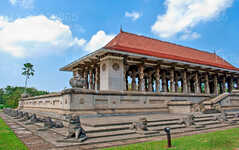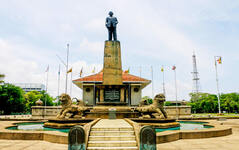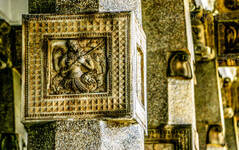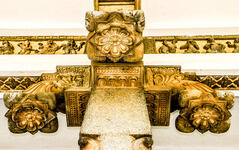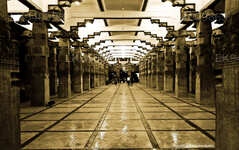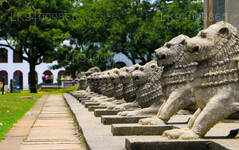
Città di Colombo
Colombo, la capitale dello Sri Lanka, è una città dinamica che fonde tradizione e modernità. Vanta un'architettura coloniale, vivaci mercati e sereni templi buddisti. Con una cucina variegata, uno skyline in continua crescita e splendide spiagge, è un vivace centro per gli affari, la cultura e il turismo, offrendo un punto di partenza ideale per esplorare le meraviglie dello Sri Lanka.
Independence Memorial Hall
A place to Remember
Independence Memorial Hall in Sri Lanka is mostly popular as a recreational venue for joggers, strolling couples, students from the nearby university and families looking for a refreshing reprieve from the urban environment of Colombo. Independence Memorial Hall is located in the Independence Square at Colombo 7. This place is known as Torrington Square in early days. This Hall was built for the commemoration of the independence from British in 1948. The hall was built at the location where the formal ceremony marking the start of self-rule, with the opening of the first parliament by the HRH Prince Henry, Duke of Gloucester occurring at a special podium February 4, 1948.
This Hall is based on the architecture of the Audience Hall( Magul Maduwa) located in Kandy. The column and pillers are decorated with traditional Sri Lankan designs and statues of lions are placed around the building. Most of the visitors had missed the museum located in the basement of the Independence Memorial Hall. This was recently renovated and displays many statues of the national heroes, who contributed to the fight for freedom from British government.
Independence Memorial Hall in Sri Lanka: Design
Every architectural square inch of this monument is filled with lavish symbols of the island’s rich history and political freedom. At the entrance to the building is an imposing statue of D.S. Senanayake, Sri Lanka’s first prime minister, surrounded by four menacing stone lions with protruding eyes. These feral guardians were recreated from the lion statues of the 13th century Yapahuwa kingdom. The most prominent feature of the monument, the assembly hall, was inspired by the “Magul Maduwa,” the royal court of the King of Kandy, the last kingdom on the island. Incidentally, it was at the Magul Maduwa that the Kandyan chieftains handed over the island’s sovereignty to the British throne in 1815.
The exterior of the assembly hall is decorated with “Punkalasas,” pots of plenty, which signify wealth and prosperity. The interior of the hall is supported by 60 pillars adorned with famous Embekke wood carvings from the 14th century Gampola kingdom. Made to the request of Premiere Senanayaka, who commissioned the building, it is said that he wanted a monument “worthy of this country’s long and impressive history.” Some of Sri Lanka’s most prominent architects labored over a number of sketches before the scrupulous premier granted his approval, making the Independence Memorial Hall one of the most meticulously designed buildings in the Colombo metropolis and even the whole country.
The Independence Memorial Hall is the ideal choice for those seeking a quick, relaxing getaway in the city. Much like the freedom it represents there are no entrance fees or stifling crowds; just the serenity and elegance of this historic monument and the freedom to explore and learn.
Recreational activities
Independence Square remains one of the nicest places to relax in Colombo, especially in the evenings. In addition to the memorial hall itself, there’s also the huge sprawling green lawn outside, the memorial museum and a number of cafes and shopping malls in the vicinity with easy access. It’s a favorite spot for joggers in the mornings and evenings. So much so that it’s easy to catch anybody taking a walk here at some point, from school kids to aunties to even President himself. There’s plenty of well-kept garden all around Independence Square and lovely clean paved pathways that run between. It cad definitely be said that besides Marine Drive or the beach, Independence Square is the best place in the city for some morning/evening exercise. There’s a free gym here and even a corner where you can rent a bicycle.
The Museum
On the inner end of the memorial hall that faces those square pools of water, you’ll find a brown door that leads to an eerily quiet memorial museum. It is quite hidden and your sure to miss it if you don’t play close attention. Check it out for stone busts of all those who fought for Sri Lanka’s independence, headed by leader of the Uva rebellion of 1818 himself; Monaravila Keppatipola Nilame. Independence Square is a pretty nice place, and thankfully it has been maintained well for as long as we can remember. It’s not just a historical space now but also a recreational park with an immaculate lawns, some food options and plenty of room for exercising and relaxing.
Informazioni sul distretto di Colomb
Colombo è la città più grande e la capitale commerciale dello Sri Lanka. Si trova sulla costa occidentale dell'isola e adiacente a Sri Jayewardenepura Kotte, la capitale dello Sri Lanka. Colombo è una città vivace e trafficata, con un mix di vita moderna, edifici e rovine coloniali e una popolazione di 647.100 abitanti. La regione metropolitana di Colombo, definita dai distretti di Colombo, Gampaha e Kalutara, ha una popolazione stimata di 5.648.000 abitanti e si estende su una superficie di 3.694,20 km². Colombo è una città multietnica e multiculturale. È la città più popolosa dello Sri Lanka, con 642.163 abitanti che vivono entro i confini della città. La popolazione di Colombo è un mix di numerosi gruppi etnici, principalmente cingalesi, mori e tamil. In città vivono anche piccole comunità di persone di origine cinese, portoghese, olandese, malese e indiana, oltre a numerosi espatriati europei. La stragrande maggioranza delle aziende dello Sri Lanka ha sede a Colombo. Alcuni dei settori industriali includono prodotti chimici, tessili, vetro, cemento, pelletteria, arredamento e gioielleria. Nel centro città si trova il secondo edificio più alto dell'Asia meridionale: il World Trade Center.
Informazioni sulla provincia occidentale
La Provincia Occidentale è la provincia più densamente popolata dello Sri Lanka. Ospita la capitale legislativa Sri Jayawardenepura Kotte e Colombo, il centro amministrativo e commerciale della nazione. La Provincia Occidentale è divisa in 3 distretti principali: Colombo (642 km²), Gampaha (1.386,6 km²) e Kalutara (1.606 km²). Essendo il fulcro economico dello Sri Lanka, tutte le principali aziende locali e internazionali hanno sede in città, così come i principali negozi di stilisti e grandi magazzini, quindi preparatevi a concedervi un po' di shopping nella Provincia Occidentale. Avendo la popolazione più alta di tutte le province, quasi tutti i principali istituti scolastici dell'isola si trovano nella Provincia Occidentale. Le università della provincia includono l'Università di Colombo, l'Università di Sri Jayewardenepura, l'Università di Kelaniya, l'Università Aperta dello Sri Lanka, l'Università Buddista e Pali dello Sri Lanka, l'Università della Difesa Generale Sir John Kotelawala e l'Università di Moratuwa. La provincia occidentale ospita il maggior numero di scuole del paese, tra cui scuole nazionali, provinciali, private e internazionali.

